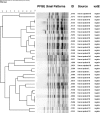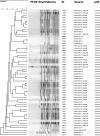Quinupristin-dalfopristin resistance in Enterococcus faecium isolates from humans, farm animals, and grocery store meat in the United States
- PMID: 16954273
- PMCID: PMC1594738
- DOI: 10.1128/JCM.02412-05
Quinupristin-dalfopristin resistance in Enterococcus faecium isolates from humans, farm animals, and grocery store meat in the United States
Abstract
Three hundred sixty-one quinupristin-dalfopristin (Q-D)-resistant Enterococcus faecium (QDREF) isolates were isolated from humans, turkeys, chickens, swine, dairy and beef cattle from farms, chicken carcasses, and ground pork from grocery stores in the United States from 1995 to 2003. These isolates were evaluated by pulsed-field gel electrophoresis (PFGE) to determine possible commonality between QDREF isolates from human and animal sources. PCR was performed to detect the streptogramin resistance genes vatD, vatE, and vgbA and the macrolide resistance gene ermB to determine the genetic mechanism of resistance in these isolates. QDREF from humans did not have PFGE patterns similar to those from animal sources. vatE was found in 35%, 26%, and 2% of QDREF isolates from turkeys, chickens, and humans, respectively, and was not found in QDREF isolates from other sources. ermB was commonly found in QDREF isolates from all sources. Known streptogramin resistance genes were absent in the majority of isolates, suggesting the presence of other, as-yet-undetermined, mechanisms of Q-D resistance.
Figures



References
-
- Aarestrup, F. M., A. M. Seyfarth, H.-D. Emborg, K. Pedersen, R. S. Hendriksen, and F. Bager. 2001. Effect of abolishment of the use of antimicrobial agents for growth promotion on occurrence of antimicrobial resistance in fecal enterococci from food animals in Denmark. Antimicrob. Agents Chemother. 45:2054-2059. - PMC - PubMed
-
- Aarestrup, F. M., Y. Agerso, P. Gerner-Smidt, M. Madsen, and L. B. Jensen. 2000. Comparison of antimicrobial resistance phenotypes and resistance genes in Enterococcus faecalis and Enterococcus faecium from humans in the community, broilers and pigs in Denmark. Diagn. Microbiol. Infect. Dis. 37:127-137. - PubMed
-
- Allignet, J., V. Loncle, P. Mazodier, and N. El Solh. 1988. Nucleotide sequence of staphylococcal plasmid gene, vgb, encoding a hydrolase inactivating the B components of virginiamycin-like antibiotics. Plasmid 20:271-275. - PubMed
-
- Bager, F., M. Madsen, J. Christensen, and F. M. Aarestrup. 1997. Avoparcin used as a growth promoter is associated with the occurrence of vancomycin-resistant Enterococcus faecium on Danish poultry and pig farms. Prev. Vet. Med. 31:95-112. - PubMed
Publication types
MeSH terms
Substances
Grants and funding
LinkOut - more resources
Full Text Sources
Medical

